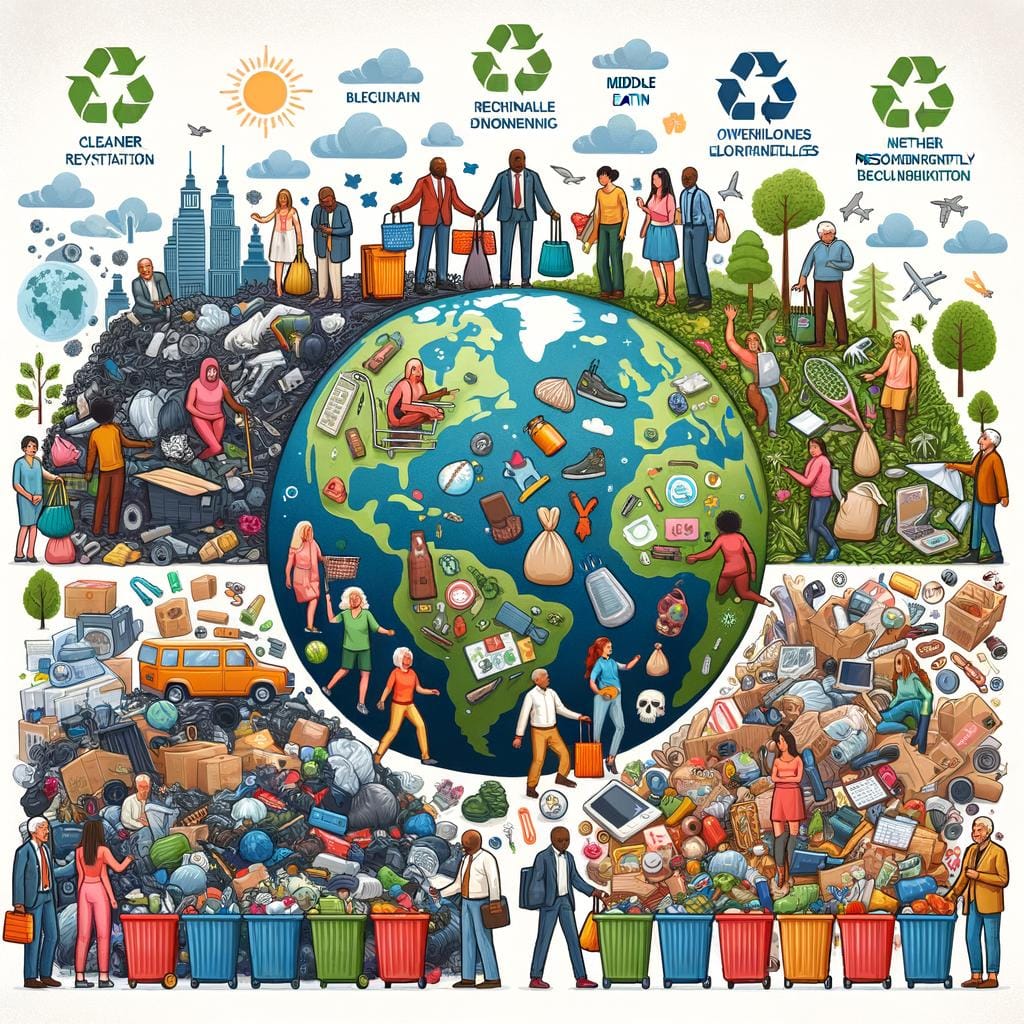In today’s increasingly eco-conscious world, the concept of reducing carbon footprint through decluttering has gained significant attention. By decluttering our spaces and lifestyles, we not only create a more organized environment but also actively contribute to minimizing our impact on the planet. This process involves reassessing our consumption habits, reducing unnecessary belongings, and adopting sustainable practices to dispose of unwanted items.
Clutter not only affects our physical spaces but also has environmental consequences. The accumulation of unnecessary items leads to increased waste production, higher energy consumption for storage and maintenance, as well as a higher demand for new products that contribute to greenhouse gas emissions. By understanding the relationship between clutter and carbon footprint, individuals can make informed choices to lessen their environmental impact through decluttering.
The benefits of decluttering extend beyond just creating a tidy living space. It can have a positive ripple effect on the environment by reducing resource consumption, promoting responsible consumption habits, and minimizing waste generation. Decluttering enables individuals to streamline their possessions, leading to a more intentional lifestyle focused on sustainability and conscious consumerism. Stay tuned as we delve deeper into the environmental impact of clutter and explore practical tips for effective decluttering techniques that help minimize carbon footprint.
The Environmental Impact of Clutter
One of the often-overlooked aspects of reducing carbon footprint is the environmental impact of clutter. Clutter not only affects physical space but also has significant consequences for the environment. When our living spaces are cluttered with unnecessary items, it leads to increased energy consumption for storage, maintenance, and even disposal. This excess consumption of resources translates to a larger carbon footprint due to the energy required to produce, transport, and manage these items.
In addition to the energy consumption associated with clutter, there is also a waste management issue that contributes to environmental degradation. When we accumulate more possessions than we need, there is a higher likelihood of items ending up in landfills.
Decomposing waste in landfills produces greenhouse gases such as methane, which are potent contributors to climate change. By decluttering our living spaces and being mindful of our consumption habits, we can directly reduce the amount of waste generated and its negative impact on the environment.
Furthermore, clutter can hinder sustainable practices in our daily lives. It can impede efforts to recycle effectively, as it creates confusion and makes it difficult to separate recyclables from general waste. By simplifying our living spaces through decluttering, we can streamline our recycling process and make it easier to adopt sustainable habits. Ultimately, by recognizing the link between decluttering and reducing carbon footprint, individuals can take meaningful steps towards minimizing their environmental impact while creating a more sustainable lifestyle.
| Environmental Impact | Consequences |
|---|---|
| Increased energy consumption for storage | Larger carbon footprint |
| Waste management issues | Greenhouse gas emissions from landfills |
| Hinders sustainable practices | Difficulty in effective recycling |
Benefits of Decluttering
Decluttering your living or working spaces not only brings a sense of organization and clarity but also has a positive impact on the environment. By reducing unnecessary items in your surroundings, you are effectively decreasing your carbon footprint. When we accumulate excess belongings, we often end up purchasing more than we need, leading to increased production demands and energy consumption. By decluttering, you are actively participating in sustainable practices that decrease the demand for new products and resources.
Reducing Energy Consumption
One of the key benefits of decluttering is the potential reduction in energy consumption. Cluttered spaces require more energy for heating, cooling, and lighting as airflow is restricted and surfaces are obstructed. By simplifying your living or working area through decluttering, you can optimize airflow and natural light which may reduce your reliance on artificial heating or cooling systems. This simple act can significantly lower your carbon footprint by decreasing the amount of energy needed to maintain a comfortable environment.
Promoting Responsible Consumption
Decluttering encourages individuals to be more mindful of their consumption habits. When you take stock of your belongings during the decluttering process, you become more aware of what you actually use and need. This awareness leads to more responsible purchasing decisions in the future, reducing unnecessary waste and supporting sustainability efforts. By consciously decluttering and reevaluating your possessions, you become an active participant in reducing carbon emissions associated with overconsumption and wasteful practices.
Decluttering Techniques
Reducing our carbon footprint through decluttering not only helps create a more organized living space but also has significant environmental benefits. By getting rid of unnecessary items and excess clutter in our homes, we can reduce the amount of waste that goes to landfills, ultimately decreasing greenhouse gas emissions. Here are some practical tips on how to effectively declutter and lower our carbon footprint:
- Start small: Begin decluttering one room at a time to make the process more manageable and less overwhelming.
- Donate or sell items: Instead of throwing away unwanted possessions, consider donating them to charity or selling them online to give them a second life.
- Recycle responsibly: Separate items that can be recycled such as paper, plastics, and electronics to ensure they are disposed of properly and do not contribute to pollution.
Implementing these decluttering techniques not only helps us achieve a cleaner and more organized living space but also contributes to the larger goal of reducing our carbon footprint. By being mindful of what we keep in our homes and how we dispose of unwanted items, we can play a part in creating a more sustainable environment for future generations.
Sustainable Practices
In today’s society, where consumerism and waste are rampant, finding sustainable practices to dispose of unwanted items during decluttering is crucial for reducing our carbon footprint. When we declutter our homes, we not only create a more organized living space but also have the opportunity to make environmentally-conscious decisions about what happens to the items we no longer need.
By opting for eco-friendly disposal methods, we can contribute to minimizing the negative impact of excess waste on the environment.
Recycling and Upcycling
One of the most effective ways to reduce waste during decluttering is by recycling and upcycling items instead of immediately throwing them away. Recycling materials like paper, plastic, glass, and metal helps divert these items from landfills and reduces the energy required to produce new products from raw materials. Upcycling, on the other hand, involves creatively repurposing old belongings into new and useful items. This not only prevents unnecessary waste but also promotes creativity and sustainability in our daily lives.
Donation and Reuse
Another sustainable practice when decluttering is donating or reusing items that are still in good condition. By giving away clothes, furniture, appliances, and other household goods to charities or thrift stores, we extend the lifespan of these items and reduce the demand for new products.
Not only does this help those in need, but it also minimizes the environmental impact of manufacturing new goods by keeping existing resources in circulation for longer periods. Additionally, sharing or swapping belongings with friends, family members, or neighbors promotes a sense of community while reducing our carbon footprint through collaborative consumption.
Minimalism and Sustainability
Minimalism is not just about having a neat and organized living space, but it also has a significant impact on reducing one’s carbon footprint. By adopting minimalist principles, individuals can successfully declutter their homes and lifestyles, ultimately leading to a more sustainable way of living. Here are some ways in which minimalism and sustainability intersect:
- Quality Over Quantity: Minimalism emphasizes owning fewer possessions but ones that are high quality and serve a purpose. This mindset reduces the production and consumption of unnecessary goods, which in turn leads to lower carbon emissions from manufacturing processes.
- Less Waste: With less clutter in our lives, there is less waste generated. By being intentional about what we own and consume, we can reduce the amount of trash that ends up in landfills, contributing to a cleaner environment with lower greenhouse gas emissions.
- Mindful Consumption: Minimalism encourages mindful consumption by evaluating our true needs versus wants. This shift in mindset not only helps in decluttering our spaces but also aids in reducing the demand for resources that have detrimental environmental impacts.
By embracing minimalism as a lifestyle choice, individuals can actively participate in reducing their carbon footprint through decluttering efforts. It’s not just about tidying up our homes; it’s about making conscious decisions that benefit both ourselves and the planet. The principles of minimalism align perfectly with sustainability goals, creating a harmonious relationship between our living spaces and the environment.
Case Studies
One inspiring case study comes from a family in a suburban neighborhood who decided to embark on a decluttering journey to reduce their carbon footprint. By decluttering their home and adopting a minimalist lifestyle, they were able to significantly decrease the amount of waste they generated.
This family took the extra step of donating gently used items to local charities and thrift stores, ensuring that their discarded possessions found new homes instead of ending up in landfills. Through this process, they not only reduced their carbon footprint but also contributed to the community by giving back through donations.
Another noteworthy example is a city-wide decluttering initiative that was implemented in a metropolitan area struggling with environmental issues. The local government organized community events focused on decluttering and recycling unwanted items. Residents were encouraged to participate by bringing in old electronics, clothes, and other household goods for proper disposal or recycling.
As a result of this collaborative effort, the city saw a significant reduction in waste sent to landfills and an increase in recycling rates. This successful campaign not only helped the environment by reducing carbon emissions but also fostered a sense of unity among residents towards achieving sustainability goals.
In a different context, a group of college students living in an off-campus housing complex took it upon themselves to initiate a decluttering challenge among their peers. They organized swap meets where students could exchange items they no longer needed, reducing the overall consumption rate within the community.
Through these collective efforts, not only did the students minimize their individual carbon footprints by practicing sustainable consumption habits but they also built stronger bonds within the student population. This case study highlights how simple initiatives at the grassroots level can have a ripple effect on reducing carbon footprint through decluttering.
| Case Study | Impact |
|---|---|
| Family in Suburban Neighborhood | Significantly decreased waste generation; Donated items to charity |
| City-Wide Initiative | Reduced landfill waste; Increased recycling rates |
| College Students’ Challenge | Promoted sustainable consumption; Built community connections |
Long-Term Impact
In conclusion, reducing carbon footprint through decluttering is not just a short-term solution but a long-lasting lifestyle choice that can have significant impacts on the environment. By embracing decluttering practices, individuals can effectively reduce the amount of waste they produce, thereby lowering their carbon footprint. This simple yet powerful act not only declutters living spaces but also contributes to a more sustainable way of living.
Moreover, the benefits of decluttering extend beyond just reducing carbon emissions. A clutter-free environment promotes mental clarity and emotional well-being, leading to a more balanced and harmonious life. This holistic approach to decluttering reinforces the idea that taking care of our surroundings ultimately benefits our overall health and quality of life.
To maintain a sustainable lifestyle after decluttering, individuals can continue to practice conscious consumerism, opting for reusable or eco-friendly products, supporting ethical brands, and adopting minimalist habits. By making these conscious choices consistently, individuals can further reduce their environmental impact and contribute positively to the planet. In essence, reducing carbon footprint through decluttering is not just an isolated activity but a transformative journey towards a greener and more sustainable future for all.
Frequently Asked Questions
How Does Decluttering Help the Environment?
Decluttering helps the environment by reducing the amount of waste being sent to landfills. When we declutter and donate items we no longer need, we minimize the demand for new products, ultimately reducing resource extraction and energy consumption.
How to Sustainably Declutter?
To sustainably declutter, it’s important to focus on reusing and recycling items whenever possible instead of simply throwing them away. Consider donating unwanted items to thrift stores or local charities, selling them online, or repurposing them for a new use in your home.
What Are 5 Ways We Can Reduce Your Carbon Footprint?
One way to reduce your carbon footprint is by using public transportation, biking, walking, or carpooling instead of driving alone. Another way is to reduce energy consumption by turning off lights when not in use, using energy-efficient appliances, and unplugging electronics when not in use.
Additionally, reducing water usage, eating less meat (especially red meat), planting trees, supporting renewable energy sources are great ways to lower your carbon footprint and help combat climate change.

Hello, I’m April Denton, your go-to expert for all things home decluttering and organization. With over a decade of experience helping individuals transform their living spaces into serene, clutter-free sanctuaries, I am passionate about the life-changing benefits of decluttering. My journey into the world of organization began out of necessity, juggling a busy career and a bustling household. I quickly realized that a well-organized home was the key to a more balanced, stress-free life.





